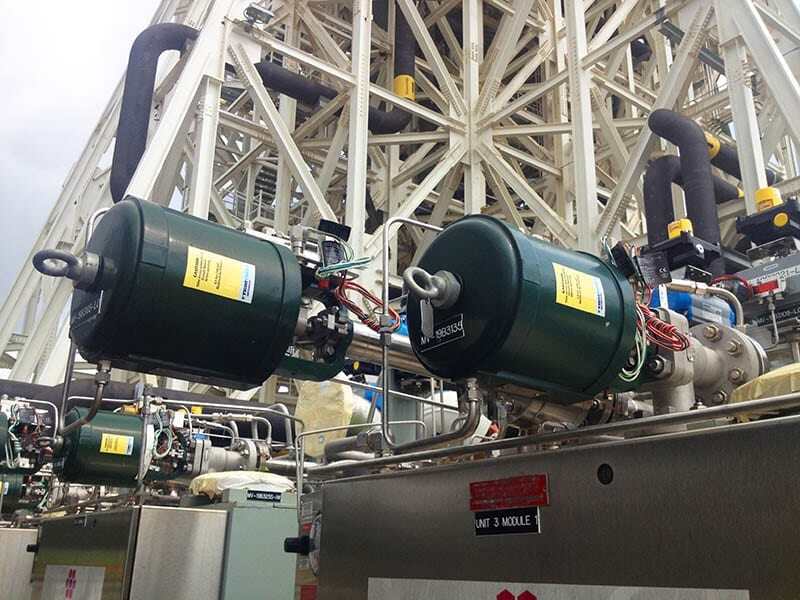Control Valves 101: Actuator Glossary
Control valves are a critical part of any process control system. But, they don’t work in isolation. In fact, most control valves rely on additional technology to function (as opposed to manual operation by humans). This includes actuators—the devices that help automate a control valve’s movement.
This is the next post in our “Control Valves 101” blog series. Here we’re focusing on the key terms you’ll need to understand how actuators work and the characteristics you need to consider when specifying one.
What is an actuator?
An actuator is any device that is mounted on a control valve and creates the motion that changes the position of the valve. Actuators can do this because they’re connected to an outside power source. They move the position of the valve in response to a specific signal, which allows engineers to automate their process control system.
Different applications require different types of actuators. But, before we explore those types, you’ll need to understand some key terms to appreciate their advantages and disadvantages.
One term that will be essential to your understanding of actuators is the valve-stem position. This is the position of the control valve relative to its fully open and fully closed positions. For example, if a control valve has a valve-stem position of 50%, it is halfway between fully opened and fully closed. Knowing this will help you understand several of the terms that follow.

Cross-section of Trimteck’s OpTK™ Linear Piston-Cylinder Actuator

Cross-sectional diagram of Trimteck’s OpTK™ Rotary Piston-Cylinder Actuator
Essential actuator terminology
Dead band: The maximum amount of energy input that is required to reverse the position of the actuator stem (and therefore change the valve-stem position).
Field-reversible: actuators with this feature allow you to easily change its direction of motion or operation without disassembly or alteration of its internal components.
Frequency response: The response of a system or device (like an actuator) to a constant amplitude sinusoidal input signal.
Hysteresis: The amount of valve-stem position error that occurs as a result of a delay or difference between the actuator and the signal it receives. Hysteresis must be monitored and controlled. This is because it can affect the accuracy, responsiveness and overall performance of process control systems.
Independent linearity: Every actuator has a stem—it’s the cylinder that moves up and down to change the valve-stem position. Independent linearity refers to the maximum amount that the actuator stem will deviate from a true straight line as it moves up and down.
Input change: Any alteration to the actuator’s control signal. Examples of control signals include voltage or hydraulic pressure. Input change triggers the actuator to alter the valve-stem position.
Maximum flow capacity: The maximum volume of air pressure that can flow into an actuator during a particular time period. Maximum flow capacity is measured in standard cubic feet per minute (SCFM).
Open-loop gain: The ratio of the imbalance that occurs when an instrument signal change is made and the actuator stem is locked up.
Rack and pinion: This is a type of actuator that converts energy into motion using a circular gear that moves along a linear gear (like a circular gear that has been straightened out).
Repeatability: A measure of the reliability of an actuator, repeatability is the degree to which an actuator can accurately repeat a valve-stem position as instructed by a signal.
Resolution: The smallest degree of change you can achieve in the valve-stem position.
Response level: The maximum amount of input change required to alter the valve-stem position. Response level only works in one direction.
Steady-state air consumption: This term applies to actuators with positioners. Positioners are needed in actuators where precise and accurate control of the valve-stem position is crucial, like those used in robotics. Steady-state air consumption refers to the ability of the positioner to consume a certain amount of air pressure to maintain the required position.
Stiffness: An actuator’s ability to hold a control valve in position, despite strong forces from the process (such as high pressure).
Stroke and stroking speed: An actuator’s stroke is its full range of movement—from fully retracted to fully extended. Its stroking speed is the amount of time, in seconds, that it needs to move from its fully retracted to its fully extended position.
Supply-pressure effect: The change of the actuator stem’s position for a 10-psi (0.7-bar) pressure change in the supply of fluid through the system.
Thrust: The degree of force that an actuator can generate in order to change the valve-stem position. Higher thrust is needed for applications that involve higher pressures.
Understanding your actuator requirements
There’s a lot to get your head around with actuators. But, you can’t specify them without also understanding the unique requirements of your process control system. Each actuator will need to harmonize with its partner control valve, as well as fit between existing pipework and other technology.
To help streamline the complexity of the specification process, we developed AccuValve™. Our state-of-the-art sizing and selection software helps you quickly identify both your actuator and control valve requirements. Then, one of our Trimteck Sales Engineers can provide you with a commercial quote within 24 hours of submitting your results. Get started today in just a few clicks.


